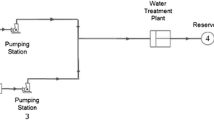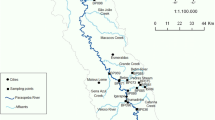Abstract
In this paper, development and optimization of a new method for determination of the three hormones (estrone, 17-β-estradiol and 17-α-ethinylestradiol) of the Watch list were described. The validated method relies on isotope dilution—two-step solid phase extraction–liquid phase chromatography mass spectrometry method. The measurement procedure validation has been performed in real matrices, including matrix with high suspended particulate matter and high organic carbon contents, to demonstrate its fitness for purpose. Method performances were in agreement with the requirements of the decision 2015/495/EU (maximal acceptable method detection limit and whole-water analysis). Limits of quantification of the method were of 0.4 ng L−1 for estrone and 17-β-estradiol and 0.1 ng L−1 for 17-α-ethinylestradiol. Expanded uncertainties (k = 2) at limit of quantification were equal to 35 % for estrone and 17-β-estradiol and 50 % for 17-α-ethinylestradiol. The method was successfully implemented to monitor French inland surface waters contamination. The survey reveals a chronic state of contamination by estrone (96 % quantification rate) and significant one by 17-β-estradiol and 17-α-ethinylestradiol (15 % quantification rate). Maximum measured concentrations are above predicted no-effect concentrations, indicating potential risk toward the environment.



Similar content being viewed by others
References
European Union (2013) Directive 2013/39/EU of the European Parliament and the Council of 12. August 2013 Amending Directives 2000/60/EC and 2008/105/EC as Regards Priority Substances in the Field of water policy. OJ L226, p 1, Accessed 24 Aug 2013
European Union (2015) Decision (EU) 2015/495 of 20 March 2015 establishing a watch list of substances for Union-wide monitoring in the field of water policy pursuant to Directive 2008/105/EC of the European Parliament and of the Council
Barreiros L, Queiroz JF, Magalhães LM, Silva AMT, Segundo MA (2016) Analysis of 17-β-estradiol and 17-α-ethinylestradiol in biological and environmental matrices—a review. Microchem J 126:243–262
Loos R (2015) Analytical methods for possible WFD 1st watch list substances. EUR 27046 EN
Adeel M, Song X, Wang Y, Francis D, Yang Y (2017) Environmental impact of estrogens on human, animal and plant life: a critical review. Environ Int 99:107–119
Mompelat S, Jaffrezic A, Jarde E, LeBot B (2013) Review storage of natural water samples and preservation techniques for pharmaceutical quantification. Talanta 109:31–45
Nie M, Yan C, Dong W, Liu M, Zhou J, Yang Y (2015) Occurrence, distribution and risk assessment of estrogens in surface water, suspended particulate matter, and sediments of the Yangtze Estuary. Chemosphere 127:109–116
Nie M, Yang Y, Liu M, Yan C, Shi H, Dong W, Zhou JL (2014) Environmental estrogens in a drinking water reservoir area in Shanghai: occurrence, colloidal contribution and risk assessment. Sci Total Environ 487:785–791
Sangster JL, Oke H, Zhang Y, Bartelt-Hunt SL (2015) The effect of particle size on sorption of estrogens, androgens and progestagens in aquatic sediment. J Hazard Mater 299:112–121
Yang L, Cheng Q, Lin L, Wang X, Chen B, Luan T, Tam NFY (2016) Partitions and vertical profiles of 9 endocrine disrupting chemicals in an estuarine environment: effect of tide, particle size and salinity. Environ Pollut 211:58–66
Petrovic M (2014) Review methodological challenges of multi-residue analysis of pharmaceuticals in environmental samples. Trends Anal Chem 1:25–33
Ademollo N, Patrolecco L, Polesello S, Valsecchi S, Wollgast J, Mariani G, Hanke G (2012) The analytical problem of measuring total concentrations of organic pollutants in whole water. Trends Anal Chem 36:71–81
Neale PA, Pronk W, Schaëfer AI (2009) Influence of pH on losses of analyte estradiol in sample prefiltration. Environ Eng Sci 26:1157–1161
de Graaff MS, Vieno NM, Kujawa-Roeleveld K, Zeeman G, Temmink H, Buisman CJN (2011) Fate of hormones and pharmaceuticals during combined anaerobic treatment and nitrogen removal by partial nitritation-anammox in vacuum collected black water. Water Res 45:375–383
Erger C, Schmidt TC (2014) Disk-based solid-phase extraction analysis of organic substances in water. Trends Anal Chem 61:74–82
EN 16691 (2015) Water quality—determination of selected polycyclic aromatic hydrocarbons (PAH) in whole water samples—method using solid phase extraction (SPE) with SPE-disks combined with gas chromatography mass spectrometry (GC–MS), February 2015, AFNOR, La Plaine Saint Denis
EN 16693 (2015) Water quality—determination of organochlorine pesticides (OCP) in whole water samples—method using solid phase extraction (SPE) with SPE-disks combined with gas chromatography mass spectrometry (GC–MS) November 2015, AFNOR, La Plaine Saint Denis
EN 16694 (2015) Water quality—determination of selected polybrominated diphenly ether (PBDE) in whole water samples—method using solid phase extraction (SPE) with SPE-disks combined with gas chromatography–mass spectrometry (GC–MS) November 2015, AFNOR, La Plaine Saint Denis
Noppe H, De Wasch K, Poelmans S, Van Hoof N, Verslycke T, Janssen CR, De Brabander HF (2005) Development and validation of an analytical method for detection of estrogens in water. Anal Bioanal Chem 382:91–98
Česen M, Heath E (2017) Disk-based solid phase extraction for the determination of diclofenac and steroidal estrogens E1, E2 and EE2 listed in the WFD watch list by GC–MS. Sci Total Environ 590–591:832–837
Qi BL, Liu P, Wang QY, Cai WJ, Yuan BF, Feng YQ (2014) Derivatization for liquid chromatography–mass spectrometry. Trends Anal Chem 59:121–132
Bichon E, Béasse A, Prevost S, Christien S, Courant F, Monteau F, Le Bizec B (2012) Improvement of estradiol esters monitoring in bovine hair by dansylation and liquid chromatography/tandem mass spectrometry analysis in multiple reaction monitoring and precursor ion scan modes. Rapid Commun Mass Spectrom 26:819–827
Lien GW, Chen CY, Wang GS (2009) Comparison of electrospray ionization, atmospheric pressure chemical ionization and atmospheric pressure photoionization for determining estrogenic chemicals in water by liquid chromatography tandem mass spectrometry with chemical derivatizations. J Chrom A 1216:956–966
Zhang F, Bartels MJ, Brodeur JC, McClymont EL, Woodburn KB (2004) Quantitation of 17α-ethinylestradiol in aquatic samples using liquid–liquid phase extraction, dansyl derivatization, and liquid chromatography/positive electrospray tandem mass spectrometry. Rapid Commun Mass Spectrom 18:2739–2742
AFNOR, NF T 90-210, Water quality—protocol for the initial method performance assessment in a laboratory, La Plaine Saint-Denis, France, May 2009
ISO 11352 Water quality—estimation of measurement uncertainty based on validation and quality control data, La Plaine Saint-Denis, France, February 2012
Capdeville MJ, Budzinski H (2011) Trace-level analysis of organic contaminants in drinking waters and groundwaters. Trends Anal Chem 30:586–606
Devier MH, Le Menach K, Viglino L, Di Gioia L, Lachassagne P, Budzinski H (2013) Ultra-trace analysis of hormones, pharmaceutical substances, alkylphenols and phthalates in two French natural mineral waters. Sci Total Environ 443:621–632
Esteban S, Gorga M, Petrovic M, González-Alonso S, Barceló D, Valcárcel Y (2014) Analysis and occurrence of endocrine-disrupting compounds and estrogenic activity in the surface waters of Central Spain. Sci Total Environ 466–467:939–951
Avar P, Zrínyi Z, Maász G, Takátsy A, Lovas S, Tóth LG, Pirger Z (2016) β-Estradiol and ethinyl-estradiol contamination in the rivers of the Carpathian Basin. Environ Sci Pollut Res 23:11630–11638
Tavazzi S, Mariani G, Comero S, Ricci M, Paracchini B, Skejo H, Gawlik BM (2016) Water framework directive watch list method analytical method for the determination of compounds selected for the first surface water watch list. EUR 27813EN
Loos R, Gawlik BM, Locoro G, Rimaviciute E, Contini S, Bidoglio G (2009) EU-wide survey of polar organic persistent pollutants in European river waters. Environ Pollut 157:561–568
MUKIT. http://www.syke.fi/en-us/Services/Calibration_services_and_contract_laboratory/MUkit__Measurement_Uncertainty_Kit. Accessed 10 Apr 2018
Acknowledgements
This work was supported by the French Agency for Biodiversity (AFB) and national reference laboratory for monitoring aquatic Environments (AQUAREF). The authors acknowledge the six French water agencies for sampling.
Author information
Authors and Affiliations
Corresponding author
Electronic supplementary material
Below is the link to the electronic supplementary material.
Rights and permissions
About this article
Cite this article
Lardy-Fontan, S., Le Diouron, V., Fallot, C. et al. Toward the determination of estrogenic compounds in the framework of EU watch list: validation and implementation of a two-step solid phase extraction–liquid phase chromatography coupled to tandem mass spectrometry method. Accred Qual Assur 23, 285–295 (2018). https://doi.org/10.1007/s00769-018-1346-4
Received:
Accepted:
Published:
Issue Date:
DOI: https://doi.org/10.1007/s00769-018-1346-4




